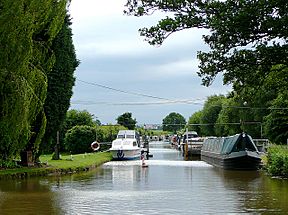Huddlesford Junction facts for kids
Huddlesford Junction is a special place where two canals meet. It's like a crossroads for boats! This junction is found near Lichfield in Staffordshire, England. Here, the Wyrley and Essington Canal (now mostly known as the Lichfield Canal) originally met the Coventry Canal.
Contents
The Story of Huddlesford Junction
Canals were very important long ago for moving goods like coal. Building them took a lot of planning and hard work.
Building the Coventry Canal
The idea for the Coventry Canal started in 1768. The plan was to build a waterway from Coventry all the way to the Grand Trunk Canal (which is now called the Trent and Mersey Canal).
Work began quickly. By 1769, the first 10 kilometres (about 6 miles) of the canal were open. This section went from Coventry to Bedworth, where there were coal mines. Moving coal by canal was much easier than by road, so it became a very busy route. Two years later, the canal reached Atherstone. However, building canals was expensive, and the company ran out of money. They needed to build eleven locks at Atherstone, but they couldn't afford it.
Connecting More Canals
Thirteen years later, in 1784, another canal called the Birmingham and Fazeley Canal was planned. This new canal would connect to the Coventry Canal at a place called Fazeley Junction. Before they started building, the canal companies talked to each other. They wanted to make sure that once the canals were finished, lots of goods would be moved, making everyone money.
The Oxford Canal agreed to finish its route to link up with the River Thames. The rest of the Coventry Canal would be built in three parts. The Coventry Canal company would finish their section from Atherstone to Fazeley. The Birmingham and Fazeley Canal company would build the next part to Whittington Brook. Finally, the Trent and Mersey Canal company would build the last section to Fradley. It was unusual for different companies to work together like this, but it meant the whole canal network was finished by 1790.
The Wyrley and Essington Canal Arrives
The last piece of the puzzle was the Wyrley and Essington Canal. This canal was approved in 1792. It was meant to carry coal from mines in Wyrley and Essington to Wolverhampton. Soon after starting, they decided to extend the canal even further.
The Wyrley and Essington Canal was extended, passing through Lichfield and going down 30 locks to reach Huddlesford Junction. This junction was on the part of the Coventry Canal that the Trent and Mersey company had built. The Coventry company later bought this section back. The Wyrley and Essington Canal, including Huddlesford Junction, opened on May 8, 1797. At first, boats sometimes struggled because there wasn't always enough water in the canal's locked sections. This problem was fixed when a new reservoir was completed in 1800.
Bringing the Canal Back to Life
Over time, parts of the Wyrley and Essington Canal were used less and less. The section east of Ogley Junction was officially closed in 1954.
However, since 1990, amazing work has been happening! The Lichfield and Hatherton Canals Restoration Trust has been busy digging out and rebuilding parts of the canal. This restored canal is now called the Lichfield Canal. The Trust hopes to have the whole canal open again by 2026. Right now, only a small part of the Lichfield Canal, from Huddlesford Junction to Cappers Lane Bridge, is used by boats for mooring (parking).
Where is Huddlesford Junction?
Huddlesford Junction is about 4 kilometres (2.5 miles) south of Fradley Junction. At Fradley, the Coventry Canal meets the Trent and Mersey Canal. There are no locks right at Huddlesford Junction.
Nearby Attractions
Right next to Huddlesford Junction, you'll find The Plough. It's a country pub and restaurant made of red brick.
Also nearby is the Lichfield Cruising Club. This is a club for boat owners who use the first 0.4 kilometres (0.25 miles) of the Lichfield Canal to moor their boats. Boat owners started parking their boats here informally in 1959. Back then, the watered section of the canal was often full of mud and weeds. The Lichfield Cruising Club was officially set up in 1978. Since then, members have worked hard to clean up the area. They've removed mud and weeds, and even turned old cottages into a clubhouse. They also added a turning point for boats and a slipway near Capers Lane Bridge.
Panorama



